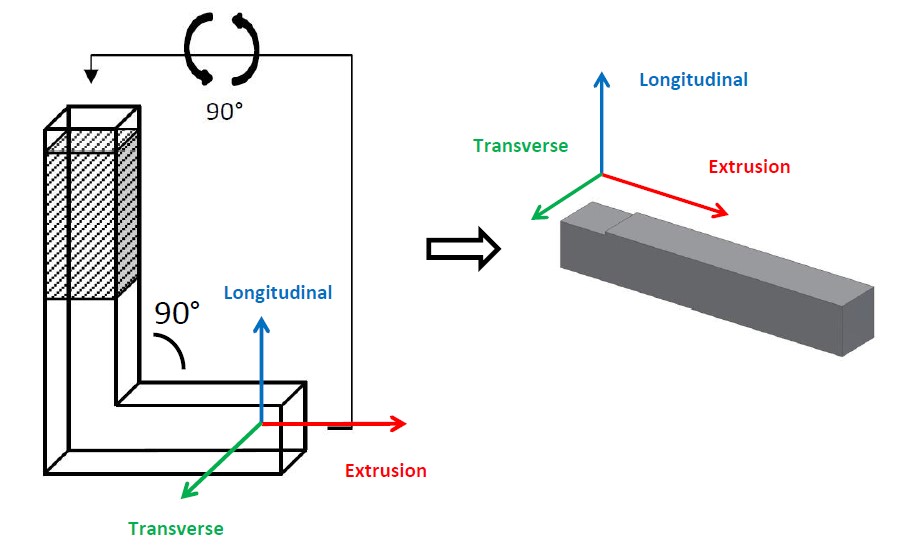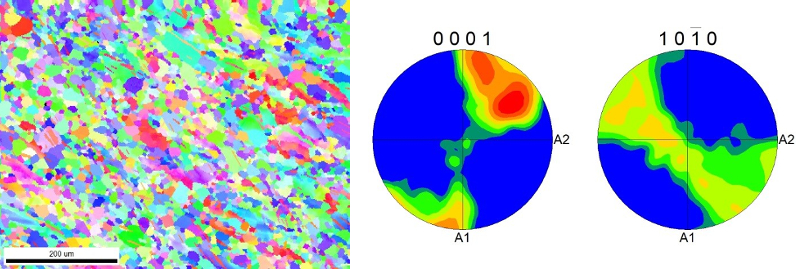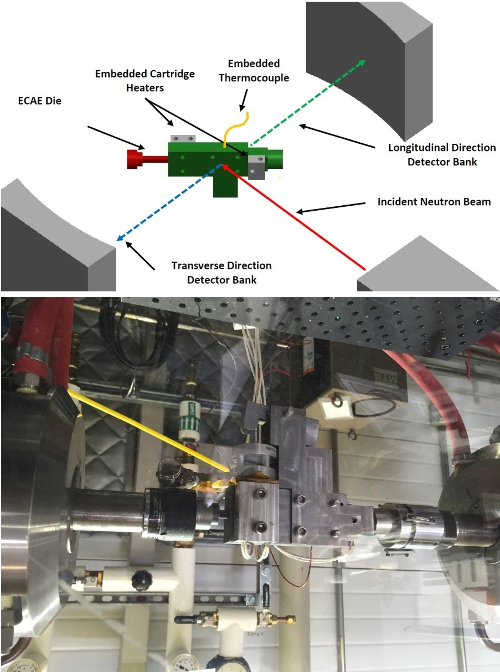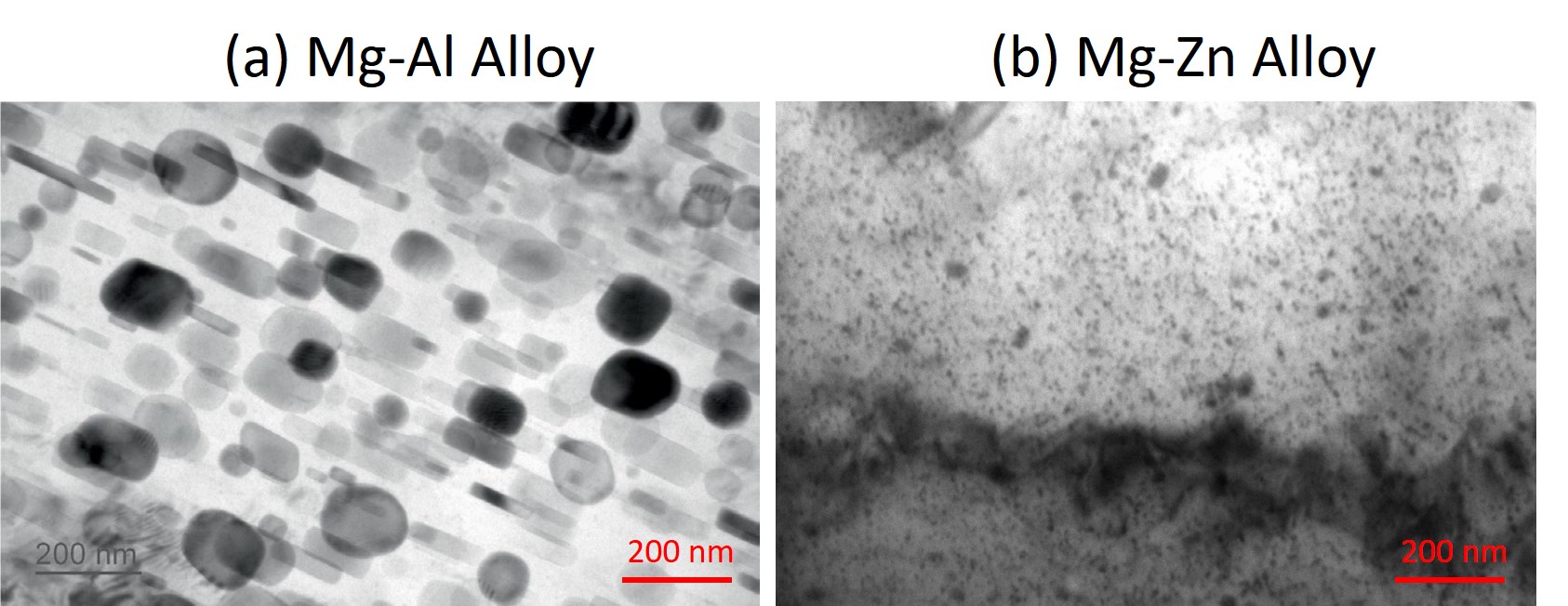There has been renewed interest in utilizing Mg as a structural metal because it is very lightweight and can achieve high strengths if processed appropriately. However, traditional mechanical processing is difficult due to Mg’s limited slip systems and anisotropic material properties. A severe plastic deformation (SPD) method, Equal Channel Angular Extrusion (ECAE), shown below, has achieved good results with Mg at elevated temperatures.

This project investigates the effect of temperature, strain rate, and processing route on the microstructural evolution of Mg alloys, such as AZ31B, Mg-Al, and Mg-Zn-Ca. Electron backscatter diffraction (EBSD) and other microscopy techniques (such as transmission electron microscopy (TEM)) are being used to characterize the resulting microstructures.

Dynamic Recrystallization
Of particular interest in the thermo-mechanical processing of Mg is a recovery-like process called dynamic recrystallization (DRX). During DRX, new grains nucleate and grow, generally resulting in grains with fewer dislocations than the parent grains and a change in texture. DRX occurs readily in Mg at many of the temperatures and strain-rates used in ECAE and is a significant factor in the resultant mechanical properties, but the process and mechanisms involved are poorly understood. To remedy this, in-situ diffraction neutron experiments have been performed during ECAE to provide insight into orientation evolution and grain growth during DRX. The analysis of these results is ongoing.

Mg-Zn-Ca Alloys: Grain Size Strengthening
The push for the use of lightweight metals in structural applications has sparked an interest in Mg alloys, as Mg alloys offer high specific strengths [1]. Due to Mg’s hexagonal close-packed crystal structure, the processing of Mg is challenging [2]. However, the use of Equal Channel Angular Extrusion (ECAE) to fabricate Mg alloys has been successful, as it creates very fine-grained microstructures [3, 4, 5]. In addition to the use of grain refinement as a strengthening mechanism, researchers have investigated the use of precipitation-hardening in Mg alloys; however, it has been found that large precipitates may lead to spall failure (relevant to ballistic performance for military armor applications) [6]. Thus, this project focuses on the ECAE processing of dilute Mg-Zn-Ca alloys, with the goal of refining the grains while producing minimal precipitates. By strengthening these alloys primarily through grain refinement (without relying on precipitation-strengthening), there may be less reduction in spall strength, without compromising other mechanical properties.

The overarching goal of this project is to process dilute Mg-Zn-Ca alloys via ECAE to obtain a very uniform, fine microstructure, with minimal precipitates. Grain size and texture will be determined before and after ECAE, using electron backscatter diffraction (EBSD). Mechanical testing (hardness/Nanoindentation, micro-tension/compression, etc.) will also be performed to assess the mechanical behavior of these alloys at various strain rates.
Deformation Induced Precipitation
For many years, we have been taught to understand aging curves that are used to design Al alloys. The guidelines have worked well. However, with the rise of lightweight Magnesium (Mg) alloys, we see limitations in this conventional processing path. Precipitation hardening is limited, and new ideas are needed to enable effective precipitation hardening in Mg alloys. One viable strategy to enhance precipitation hardening response in both alloy systems is to employ the Deformation Induced Precipitation (DIP) process. The underpinning hypothesis is that a dense distribution of nanoscale precipitates and fine solute clusters can be produced by controlling the motion, density, and heterogeneity of defects generated at a low temperature. Recent results from our work show promising results where we use atomic scale defects to generate a high number density of nanoscale precipitates in binary alloys of Magnesium (Mg-Al and Mg-Zn). This project is funded by US Army Research Lab and is part of the Materials in Extreme Dynamic Environments (MEDE) academic research consortium.

References
[1] S.E. Prameela, P. Yi, Y. Hollenweger, B. Liu, J. Chen, L. Kesckes, D.M. Kochmann, M.L. Falk, T.P. Weihs, “Strengthening magnesium by design: integrating alloying and dynamic processing,” Mechanics of Materials, vol. 167, April 2022.
[2] L. Kecskes, N. Krywopusk, Y. Hollenweger, J.N. Krynicki, S.E. Prameela, P. Yi, B. Liu, M.L. Falk, D.M. Kochmann, T.P. Weihs, “Recrystallization mechanisms, grain refinement, and texture evolution during ECAE processing of Mg and its alloys,” Mechanics of Materials, vol. 162, November 2021.
[3] Y. Estrin and A. Vinogradov, “Extreme grain refinement by severe plastic deformation: A wealth of challenging science,” Acta Materialia, vol. 61, no. 3, pp. 782–817, Feb. 2013.
[4] V.M. Segal, “Materials processing by simple shear,” Materials Science and Engineering: A, vol. 197, no. 2, pp. 157–164, Jul. 1995.
[5] A. Yamashita, Z. Horita, and T.G. Langdon, “Improving the mechanical properties of magnesium and a magnesium alloy through severe plastic deformation,” Materials Science and Engineering: A, vol. 300, no. 1, pp. 142–147, Feb. 2001.
[6] N.M. Krywopusk, C.L. Williams, L.J. Kecskes, and T.P. Weihs, “Characterization of spalled AZ31B processed by ECAE,” Materials Science and Engineering: A, vol. 767, pp. 1-10, Nov. 2019.
[7] S. E. Prameela, E. Lipkin, J. Chen, L. Kecskes, Z. Xu, and T. Weihs, “Enhanced Precipitation and Recrystallization in a Mg-Zn Alloy During Low-Temperature Extrusion,” Procedia Manufacturing, vol. 47, pp. 1476–1480, Jan. 2020, DOI: 10.1016/j.promfg.2020.04.329.
[8] S. Eswarappa Prameela, P. M. McGuiggan, A. Brusini, T. W. Glenn, and T. P. Weihs, “Looking at education through the microscope,” Nature Reviews Materials, vol. 5, no. 12, pp. 865–867, Dec. 2020, DOI: 10.1038/s41578-020-00246-z.
